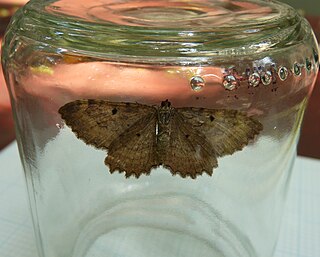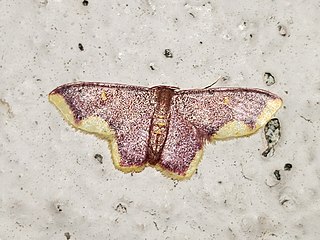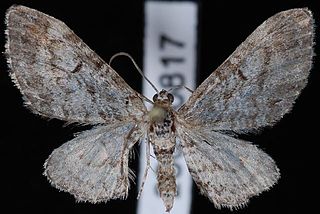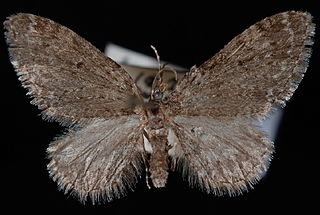
Coryphista is a monotypic moth genus in the family Geometridae erected by George Duryea Hulst in 1896. The genus may be considered to be a synonym of Rheumaptera. Its only species, Coryphista meadii, the barberry geometer moth or barberry looper, was first described by Alpheus Spring Packard in 1874. It is found in the United States and southern Canada.

Hesperumia is a genus of moths in the family Geometridae. The genus was described by Packard in 1873.

Lophosis is a monotypic geometrid moth genus. Its only species, Lophosis labeculata, the stained lophosis, is found in North America. Both the genus and species were first described by George Duryea Hulst, the genus in 1896 and the species in 1887.
Paota is a monotypic moth genus in the family Geometridae described by George Duryea Hulst in 1896. Its only species, Paota fultaria, was first described by Augustus Radcliffe Grote in 1882. It is found in North America and has a forewing length of 12 millimetres.

Spodolepis substriataria is a moth of the family Geometridae first described by George Duryea Hulst in 1896. It is found from Alaska to Nova Scotia, south in the east to New Jersey and in the west to California.

Eupithecia nimbicolor is a moth in the family Geometridae first described by George Duryea Hulst in 1896. It is found in North America from eastern Newfoundland and Labrador to western British Columbia and from Alaska to Arizona.

Eupithecia stellata is a moth in the family Geometridae first described by George Duryea Hulst in 1896. It is found in North America from central Manitoba to northern Alberta and south to California and Mexico.
Eupithecia flavigutta is a moth in the family Geometridae first described by George Duryea Hulst in 1896. It is found in the United States in Colorado and montane forest areas in eastern Arizona and south-western New Mexico.

Eupithecia graefi, or Graef's pug, is a moth in the family Geometridae. The species was first described by George Duryea Hulst in 1896. It is found in North America from south-western Alberta west to Vancouver Island, north to Alaska and south to California. The habitat consists of wooded areas.

Eupithecia misturata is a moth in the family Geometridae first described by George Duryea Hulst in 1896. It is widely distributed in western North America.
Eupithecia bivittata is a moth in the family Geometridae first described by George Duryea Hulst in 1896. It is found in coastal central California, United States.
Eupithecia cretata is a moth in the family Geometridae first described by George Duryea Hulst in 1896. It is found in the US state of Colorado.

Eupithecia annulata, the larch pug moth, is a moth in the family Geometridae. The species was first described by George Duryea Hulst in 1896. It is found in North America from British Columbia north to the Yukon, east to Newfoundland and Labrador and south to California and Colorado.
Eupithecia implorata is a moth in the family Geometridae first described by George Duryea Hulst in 1896. It is found in the US states of California and Arizona.
Eupithecia cestata is a moth in the family Geometridae first described by George Duryea Hulst in 1896. It is found in the US state of California.
Prorella leucata is a moth in the family Geometridae first described by George Duryea Hulst in 1896. It is found in North America from California through Colorado, Maine, Montana, Oregon and Utah to British Columbia.
Prorella desperata is a moth in the family Geometridae first described by George Duryea Hulst in 1896. It is found in the US states of Arizona and Texas.
Caberini is a tribe of geometrid moths in the family Geometridae. There are at least 50 described species in Caberini.
Hesperumia fumosaria is a species of geometrid moth in the family Geometridae. It is found in North America.

Hesperumia sulphuraria, known generally as the sulphur moth or sulphur wave, is a species of geometrid moth in the family Geometridae. It is found in North America.










